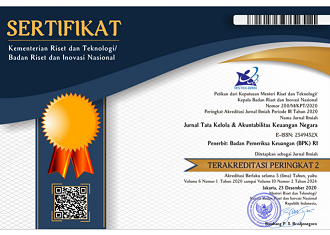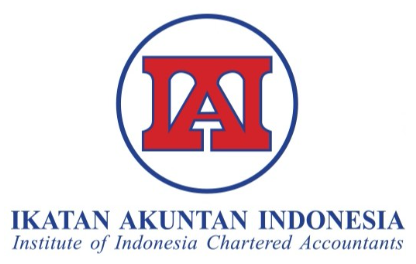BUDGET TURBULENCE AND BUDGET DEVIATION: DO LOCAL GOVERNMENT HAVE THE ABILITY TO REDUCE THEM?
DOI:
https://doi.org/10.28986/jtaken.v5i1.285Keywords:
Budget turbulence, local government ability, budget deviationAbstract
The purpose of this study is to examine and analyse the effect of local governments’ ability on the relationship between budget turbulence and budget deviation. The study sample uses the regional budget (APBD) report and realization of a number of districts/cities throughout Indonesia encompassing the 2014-2017 period, while the analysis covers the period from 2015-2017. This study uses the least square approach with EViews analysis tool version 10 to test the hypothesis. Result of the study shows that budget turbulence has a positive and significant effect on budget deviation. The result also shows that the capacity of local governments can reduce the influence of budget turbulence on the budget deviation. Sensitivity tests using proxies of local governments not sampled by the main test also show consistent results. Finally, sensitivity test by area category proves that for the three categories, mainly western, central, and eastern Indonesia, the results are consistent with the main test results. The contribution of this study to the policies of the local governments is aimed to enhance efficiency of spending and increase productive spending to support the priority of government programs and encourage efficient, innovative and sustainable financing while maintaining the investment climate. Through several of these alternatives, the local government can overcome the conditions of resource instability that can threaten the effectiveness of the implementation of various programs.References
Al-Fajri, F. (2018, September 3). Defisit anggaran APBD Rp. 900 miliar, Pemkot Bekasi gandeng KPK. Wartakota Live.com. Retrieved from http://wartakota.tribunnews.com/ 2018/09/03/defisit-anggaran-apbd-rp-900-miliar-pemkot-bekasi-gandeng-kpk.
Anessi-Pessina, E., Barbera, C., Rota, S., Sicilia, M., & Steccolini, I. (2012). Public: A review. In: Presented at 7th International Conferences on Accounting, Auditing & Management in Public Sector Reforms, Rome, Italy.
Baron, R. M., & Kenny, D. (1986). The moderator-mediator variable distinction in social psychological research: conceptual, strategic, and statistical considerations. Journal of Personality and Social Psychology, 51(6), 1173-1182.
Boland, R. J., & Pondy, L. R. (1986). The micro dynamics of a budget-cutting process: Modes, models and structure. Accounting, Organizations and Society, 11(4-5), 403-422.
Boyne, G. A., & Meier, K. J. (2009). Environmental turbulence, organizational stability, and public service performance. Administration & Society, 40(8), 799-824. doi: 10.1177/0095399708326333.
Covaleski, M. A., & Dirshmit, M. W. (1988). The use of budget symbols in the budget arena: An historical informed field study. Accounting, Organizations and Society, 13(1), 1-24.
Ghozali, I., & Ratmono, D. (2017). Analisis multivariat dan ekonometrika: Teori, konsep, dan aplikasi dengan eviews 10. Semarang: Badan Penerbit Universitas Diponegoro.
Gujarati, D., & Porter, D. C. (2009). Basic econometrics 5th Edition. New York: McGraw-Hill.
Hamid, A. A. (2018). Analisis pengaruh kinerja keuangan daerah terhadap tingkat kesejahteraan masyarakat Kabupaten Majalengka-Jawa Barat. Jurnal Sekuritas, 1(4), 38-51.
Halim, A., & Kusufi, M. S. (2014). Akuntansi sektor publik: Akuntansi keuangan daerah. Jakarta: Penerbit Salemba Empat.
Johansson, T., & Siverbo, S. (2014). The appropriateness of tight budget control in public sector organizations facing budget turbulence. Management Accounting Research, 26, 271-283.
Jonsson, S. (1982). Budget behavior in local government-a case study over 3 years. Accounting, Organizations and Society, 7(3), 287-304.
Lee, S. Y., & Whitford, A. B. (2009). Government effectiveness in comparative perspective. Journal of Comparative Policy Analysis, 11(2), 249-281.
Nugroho, R. (2017). Public policy: dinamika kebijakan publik, analisis kebijakan publik, manajemen politik kebijakan publik, etika kebijakan publik, kimia kebijakan publik. Jakarta: PT. Gramedia.
Portes, A., & Haller, W. (2010). The Informal Economy. Retrieved from https://www.academia.edu/29781396/The_Informal_Economy.
Riswan, R., & Affandi, A. (2014). Pengaruh kinerja keuangan daerah terhadap belanja modal untuk pelayanan publik dalam perspektif teori keagenan. Jurnal Akuntansi dan keuangan, 5, 71-90.
Santoso, S. (2010). Statistik parametrik, konsep dan aplikasi dengan SPSS. Jakarta: PT. Gramedia.
Wirasedana, I. W. P., Sisdyani, E. A., & Setiawan, I. P. E. (2018). Kendali budget ketat pada pemda di Provinsi Bali dalam menghadapi turbulensi budget. E-Jurnal Akuntansi, 25(1), 300-327. doi: 10.24843/EJA.2018.v25.i01.p12.
Wildavsky, A. (1975). Budgeting: A comparative theory of budget processes. Boston: Little. Brown & Co.
World Economic Forum. (2015). The global competitiveness report 2015-2016. Genewa: World Economic Forum.
Yaqin, U. A., Herwanti, T., & Akram. (2018). Komitmen pemerintah daerah dalam pengelolaan anggaran pendapatan dan belanja daerah: Studi pada Pemerintah Kota Bima. E-Jurnal Akuntansi, 25(3), 2321-2351.
Anessi-Pessina, E., Barbera, C., Rota, S., Sicilia, M., & Steccolini, I. (2012). Public: A review. In: Presented at 7th International Conferences on Accounting, Auditing & Management in Public Sector Reforms, Rome, Italy.
Baron, R. M., & Kenny, D. (1986). The moderator-mediator variable distinction in social psychological research: conceptual, strategic, and statistical considerations. Journal of Personality and Social Psychology, 51(6), 1173-1182.
Boland, R. J., & Pondy, L. R. (1986). The micro dynamics of a budget-cutting process: Modes, models and structure. Accounting, Organizations and Society, 11(4-5), 403-422.
Boyne, G. A., & Meier, K. J. (2009). Environmental turbulence, organizational stability, and public service performance. Administration & Society, 40(8), 799-824. doi: 10.1177/0095399708326333.
Covaleski, M. A., & Dirshmit, M. W. (1988). The use of budget symbols in the budget arena: An historical informed field study. Accounting, Organizations and Society, 13(1), 1-24.
Ghozali, I., & Ratmono, D. (2017). Analisis multivariat dan ekonometrika: Teori, konsep, dan aplikasi dengan eviews 10. Semarang: Badan Penerbit Universitas Diponegoro.
Gujarati, D., & Porter, D. C. (2009). Basic econometrics 5th Edition. New York: McGraw-Hill.
Hamid, A. A. (2018). Analisis pengaruh kinerja keuangan daerah terhadap tingkat kesejahteraan masyarakat Kabupaten Majalengka-Jawa Barat. Jurnal Sekuritas, 1(4), 38-51.
Halim, A., & Kusufi, M. S. (2014). Akuntansi sektor publik: Akuntansi keuangan daerah. Jakarta: Penerbit Salemba Empat.
Johansson, T., & Siverbo, S. (2014). The appropriateness of tight budget control in public sector organizations facing budget turbulence. Management Accounting Research, 26, 271-283.
Jonsson, S. (1982). Budget behavior in local government-a case study over 3 years. Accounting, Organizations and Society, 7(3), 287-304.
Lee, S. Y., & Whitford, A. B. (2009). Government effectiveness in comparative perspective. Journal of Comparative Policy Analysis, 11(2), 249-281.
Nugroho, R. (2017). Public policy: dinamika kebijakan publik, analisis kebijakan publik, manajemen politik kebijakan publik, etika kebijakan publik, kimia kebijakan publik. Jakarta: PT. Gramedia.
Portes, A., & Haller, W. (2010). The Informal Economy. Retrieved from https://www.academia.edu/29781396/The_Informal_Economy.
Riswan, R., & Affandi, A. (2014). Pengaruh kinerja keuangan daerah terhadap belanja modal untuk pelayanan publik dalam perspektif teori keagenan. Jurnal Akuntansi dan keuangan, 5, 71-90.
Santoso, S. (2010). Statistik parametrik, konsep dan aplikasi dengan SPSS. Jakarta: PT. Gramedia.
Wirasedana, I. W. P., Sisdyani, E. A., & Setiawan, I. P. E. (2018). Kendali budget ketat pada pemda di Provinsi Bali dalam menghadapi turbulensi budget. E-Jurnal Akuntansi, 25(1), 300-327. doi: 10.24843/EJA.2018.v25.i01.p12.
Wildavsky, A. (1975). Budgeting: A comparative theory of budget processes. Boston: Little. Brown & Co.
World Economic Forum. (2015). The global competitiveness report 2015-2016. Genewa: World Economic Forum.
Yaqin, U. A., Herwanti, T., & Akram. (2018). Komitmen pemerintah daerah dalam pengelolaan anggaran pendapatan dan belanja daerah: Studi pada Pemerintah Kota Bima. E-Jurnal Akuntansi, 25(3), 2321-2351.
Downloads
Submitted
2019-03-24
Accepted
2019-05-14
Published
2019-06-30
How to Cite
Herianti, E. (2019). BUDGET TURBULENCE AND BUDGET DEVIATION: DO LOCAL GOVERNMENT HAVE THE ABILITY TO REDUCE THEM?. Jurnal Tata Kelola Dan Akuntabilitas Keuangan Negara, 5(1), 1–20. https://doi.org/10.28986/jtaken.v5i1.285
Issue
Section
Articles
License

Jurnal Tata Kelola dan Akuntabilitas Keuangan Negara is licensed under
a Creative Commons Attribution-ShareAlike 4.0 International License




















